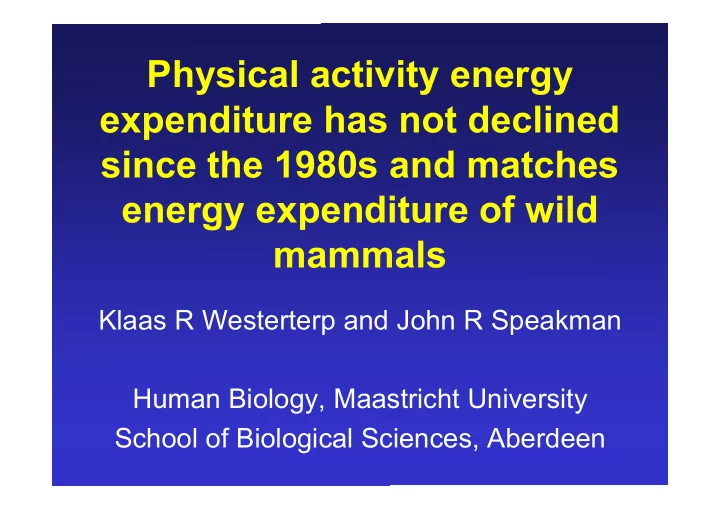

Physical activity energy expenditure has not declined since the 1980s and matches energy expenditure of wild mammals Klaas R Westerterp and John R Speakman Human Biology, Maastricht University School of Biological Sciences, Aberdeen
Background Obesity is a recent significant health issue, resulting from a protracted energy imbalance Whether this comprises excessive energy intake, lowered physical activity, or both, remains disputed
Gluttony or sloth? Prentice and Jebb. Br Med J 1995;311:437-9
Design Physical activity energy expenditure from daily energy expenditure measured with 2 H 2 18 O Trends over time back to the 1980s Measures made on wild terrestrial mammals
Subjects Maastricht data base
Assessment of physical activity energy expenditure Residual regression DEE on BEE Ratio of DEE to BEE (PAL) Residual regression DEE on body mass and sex (if BEE not available)
Regression DEE on BEE
Significant trend for increase of residual DEE-BEE in time
No significant change in PAL over time
No significant time trend of residual DEE-(weight,gender,age)
Data from North America 433 Subjects Body weight and gender dominant factors explaining DEE Significant positive effect of date of measurement on DEE after adjustment for body weight, gender and age
Data from 3 rd world countries 149 Subjects The data lie on the expected line determined by body mass, gender and age for individuals in western societies
Conclusion There is no indication that energy expenditure on physical activity or total energy expenditure have declined over the past 2 decades
Data terrestrial mammals Literature 1970-2005 90 species, 207 measurements 163 measurements with estimates of BEE in the thermoneutral zone
DEE and body mass
Best-fit regression equation Ln DEE (kJ/day) = 2.353 + 0.948 Ln(body mass g) - 0.026 Temp( 0 C) Prediction DEE modern humans (78.6 kg): 9.4 MJ/d (95% CI = 7.9-12.9 MJ/d)
Conclusion Daily energy expenditure of modern humans in Westernised societies is completely in line with the prediction from an equation derived from measurements of wild terrestrial mammals
Discussion Many wild mammals live at ambient temperatures below the thermoneutral zone, hence PAL reflects the combination of activity metabolism and energy spent on thermoregulation
PAL and body mass
Conclusion Daily energy expenditure has not declined over the duration of the obesity epidemic Modern humans do not have exceptionally low rates of energy expenditure compared with wild mammals
Conclusion Reduced energy expenditure due to lowered physical activity is unlikely to have fuelled the obesity epidemic
Recommend
More recommend